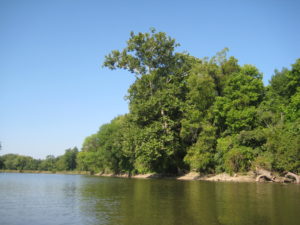The Value of Sycamore

A precarious sycamore along the Iowa River, its roots supporting smaller trees.
The sycamore is an interesting member of our sylva. Native to our floodplains, it is often found right on the edge of a creekbank, and looking precarious. But the dense lateral root system extends far back into the bank and often you can return a decade later and still find it looking precarious. The beavers seem to understand this, and on rivers too wide and flashy for building a traditional dam, they become “bank beavers” by digging a cave below the snarl of exposed roots. And they won’t cut that tree down, apparently knowing it’s in their best interest to keep it growing.
When anchored in its favored native haunts on a floodplain, with moist soils available, sycamore grows rapidly, and a quarter-century old tree can already be 70 or 80 feet tall. And they can live for centuries and grow trunks of enormous diameter. The Ohio valleys originally recorded the largest ones, some 13-15 feet in diameter. These giants were invariably hollow inside, and the pioneer literature records newly arrived families living inside one until they could build their log cabin. These were estimated to be 3-4 centuries old.
When Long’s expedition to the Rockies in 1820 passed through the Ohio River watershed, they noted (found in A Natural History of Trees of Eastern and Central North America) that “…the fruit of the sycamore is the favorite food of the paroquet, and large flocks of these gaily-plumaged birds constantly enliven the gloomy forests of Ohio.” Unfortunately, the pioneers considered them a pest to their crops and deliberately hunted our only native parrot to extinction. In the not too distant future it may be possible to genetically engineer a resurrected paroquet from museum specimens, but where would they live? Could the Appalachians and its foothills like the Hocking Hills of Ohio support this species today? Would replanting its floodplains extensively to sycamore help them survive, and with less conflict with orchards?

The native range of sycamore.
Here in southeast Iowa, we are close to the northwestern limits for sycamore and our expectations should be a bit reduced compared to Ohio.
One of the species’ growth limits here is cold, damp springtimes continuing after they have leafed out. The new leaves contract an anthracnose blight, turn black, and fall. The tree is obligated to replace them all, but experiences little loss of vigor. This happens here several times each decade, including spring 2019. More rarely it repeats in the same spring and it seems somewhat stressful to the tree to have to generate a third crop of leaves, stressful as evidenced by a smaller growth ring on a cut trunk. I’ve not seen a third onset of the problem in the same year, probably because we are by then into summer.

Sycamores along Riverside Drive.
While best adapted to floodplains, it can tolerate being a street tree and there are numerous 40-50 year olds around here. The greatest concentration is along Riverside Drive beside the UI Art Complex, but these are actually living on the edge of the floodplain and enjoy extra-damp soils.
The underside of a Sycamore leaf is covered with tiny short hairs, which are shed all summer and drift around in the breeze. If I linger for an hour beneath a large sycamore on a calm summer day, my eyes start to itch, others don’t seem to notice. Therefore, I think it may not be a good patio tree.
But in a more open setting, they serve well on floodplains and other damp places in full sun. Deer do not eat the young trees, and they grow fast enough to get ahead of the weeds within a few years. The young trees have a shallow fibrous root system, which transplants well. Modern floodplains have become more difficult places to reforest, with increased sediment loads and rapid erosion of the banks. Sycamore is one of the better-suited survivors.
On Bur Oak Land Trust properties, which are being restored to natives (for example Belgum Grove), sycamore should be expected to do well, with minimum care.
The distribution map is taken from Gary Hightshoe’s encyclopedic book Native Trees, Shrubs, and Vines for Urban and Rural North America. He chooses to not use the common name sycamore, even in the index, but you can find it there called American planetree.
Tags: Lon Drake, sycamore

